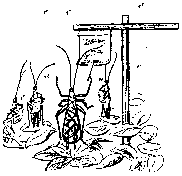|
|
|
|
|
|
|
|
|
|
|
|
|
|
|
|
|
|
|
|
|
|
|
|
|
|
|
|
|
|
|
|
|
The Snowy Tree-cricket
|
|
|
|
|
|
|
|
|
|
|
|
|
|
|
|
|
|
|
|
|
|
|
|
|
|
|
|
|
|
|
|
|
|
|
|
|
|
|
|
|
|
|
|
|
|
|

|
|
The Snowy Tree-Cricket
Teacher's Story
 HIS is a slim, ghost-like cricket. It is pale green,
almost white in color, and about three-fourths of an
inch long. Its long, slender hind legs show that it is
a good jumper. Its long antennæ, living threads,
pale gray in color, join the head with amber globe-like
segments. The pale eyes have a darker center and
the palpi are very long. The male has the
wing-covers shaped and veined like those of the black
cricket, but they are not so broad and are whitish and
very delicate. The wings beneath are wide, for these
crickets can fly. The female has a long, sword-like ovipositor.
HIS is a slim, ghost-like cricket. It is pale green,
almost white in color, and about three-fourths of an
inch long. Its long, slender hind legs show that it is
a good jumper. Its long antennæ, living threads,
pale gray in color, join the head with amber globe-like
segments. The pale eyes have a darker center and
the palpi are very long. The male has the
wing-covers shaped and veined like those of the black
cricket, but they are not so broad and are whitish and
very delicate. The wings beneath are wide, for these
crickets can fly. The female has a long, sword-like ovipositor.
The snowy tree-cricket, like its relatives, spends much time at its toilet. It whips the
front foot over an antenna and brings the base of the
latter to the mandibles with the palpi and then cleans it carefully to the
very tip. It washes its face with the front foot, always with a downward
movement. If the hind foot becomes entangled in anything it first tries
to kick it clean, and then drawing it beneath the body, bends the head so
as to reach it with the mandibles and nibbles it clean. The middle foot
it also thrusts beneath the body, bringing it forward
between the front legs for cleaning. But when
cleaning its front feet, the snowy tree-cricket puts on
airs; it lifts the elbow high and draws the foot
through the mouth with a gesture very like that of a
young lady with a seal ring on her little finger, holding the ornate member out from its companions as if
it were stiff with a consciousness of its own importance.
![[Illustration]](http://www.gatewaytotheclassics.com/bronze/books/comstock/insects/comstock_insects_zpage377a.gif)
Eggs of snowy tree-cricket,
laid in raspberry cane.
After C. V. Riley.
|
There are two common species of the snowy tree-crickets
which can hardly be separated except by
specialists or by watching their habits. One is
called "the whistler" and lives on low shrubs or
grass; it gives a clear, soft, prolonged, unbroken
note. The other is called "the fiddler" and lives on
shrubs and in trees and vines. Its note is a pianissimo performance of the katydid's song; it is
delightful, rhythmic and sleep-inspiring; it begins in the late
afternoon and continues all night until the early,
cold hours of the approaching dawn. The vivacity
of the music depends upon the temperature, as the
notes are given much more rapidly during the hot
nights.
![[Illustration]](http://www.gatewaytotheclassics.com/bronze/books/comstock/insects/comstock_insects_zpage378.gif)
Snowy tree-cricket.
|
"So far as we know, this snowy tree-cricket is the
only one of the insect musicians that seems conscious
of the fact that he belongs to an orchestra. If you
listen on a September evening, you will hear the first
player begin; soon another will join, but not in harmony at first. For some time there may be a
see-saw of accented and unaccented notes; but after a while the two will
be in unison; perhaps not, however, until many more players have joined
the concert. When the rhythmical beat is once established it is in as
perfect time as if governed by the baton of a Damrosch or a Thomas.
The throbbing of the cricket heart of September, it has
been fitly named. Sometimes an injudicious player
joins the chorus at the wrong beat, but he soon discovers
his error and rectifies it. Sometimes, also, late at night,
one part of the orchestra in an orchard gets out of time
with the majority, and discord may continue for some
moments, as if the players were too cold and too sleepy
to pay good attention. This delectable concert begins
usually in the late afternoons and continues without
ceasing until just before dawn the next morning. Many
times I have heard the close of the concert; with the
"wee sma" hours the rhythmic beat becomes slower;
toward dawn there is a falling off in the number of players;
the beat is still slower, and the notes are hoarse, as if the
fiddlers were tired and cold; finally, when only two or
three are left the music stops abruptly." (Ways of the Six-Footed,
Comstock.)
The lesson on this cricket may be adapted from that on the black
cricket.
|











